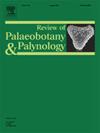Palynology, palynofacies and palaeoenvironment of the Serpukhovian Tazlourt Formation (Tinghir region, southern margin of the Variscan Zone, SE Morocco)
IF 1.7
3区 地球科学
Q2 PALEONTOLOGY
引用次数: 0
Abstract
The microfloristic study of limestones from the Tazlourt Formation in the Tinghir region, led to the first discovery of miospores of herbaceous and sub-arborescent lycopsids small fern and sphenopsids belonging to both non-forest mire and forest mire. The palynological assemblage also includes rare marine phytoplankton (i.e. Lophosphaeridium spp.). Among the continental palynomorphs, significant marker taxa, such as Grandispora spinosa, Dictyotriletes bireticulatus, Cirratriradites cf. C. rarus, Schulzospora cf. S. campyloptera and Punctatisporites gretensis enable a confident attribution to the upper Serpukhovian stage (the subtriquetra–ornatus or SO miospore Zone of the Western Europe). This proves the presence of uppermost Mississippian deposits at the southern front of the Moroccan Variscan chain. The kerogen released by the analyzed samples is predominantly of continental origin, mainly composed of opaque phytoclasts with different sizes and shapes, while translucent phytoclasts and miospores are less represented. The analysis of microfacies, as well as the qualitative and quantitative parameters of the various components of the palynofacies, indicates a shallow to moderately deep neritic environment and supports the existence of a connection to the “Variscan Sea” between the Anti-Atlas domain, located on the northwestern margin of the stable Gondwana craton, and the Moroccan Hercynides, situated at the southwestern margin of the Variscides. The miospores are characterized by significant alteration in texture and color, with Spore Color Index (SCI) values ranging from 7 to 9 and advanced silicification. This is likely related to the combination of tectonic events that affected the study area during the Meso- and Post-Variscan phases.
摩洛哥东南部Variscan带南缘Tinghir地区Serpukhovian Tazlourt组孢粉学、孢粉相及古环境
通过对Tinghir地区Tazlourt组灰岩的微区系研究,首次发现了草本和亚乔木石松类、小蕨类和桫椤类的小孢子,它们属于非森林沼泽和森林沼泽。孢粉组合还包括稀有的海洋浮游植物(如Lophosphaeridium spp.)。在大陆的孢子类中,有重要的标志分类群,如大孢子虫、双网三叶虫、Cirratriradites cf. C. rarus、Schulzospora cf. S. campyloptera和Punctatisporites gretensis,可以肯定地归属于Serpukhovian的上阶段(西欧的亚三孢子带或SO小孢子带)。这证明了在摩洛哥瓦里斯坎链的南部前沿存在密西西比最上层的矿床。分析样品释放的干酪根以陆源干酪根为主,主要由不同大小和形状的不透明植物碎屑组成,而半透明植物碎屑和微孢子较少。微相分析及孢粉相各组分的定性和定量参数表明,该区为浅海至中深浅海环境,支持位于稳定的冈瓦纳克拉通西北缘的反阿特拉斯域与位于瓦里西底斯西南缘的摩洛哥海西尼德之间存在与“瓦里西坎海”的联系。孢子颜色指数(Spore color Index, SCI)在7 ~ 9之间,呈高度硅化。这可能与中、后瓦里斯坎期影响研究区的构造事件的组合有关。
本文章由计算机程序翻译,如有差异,请以英文原文为准。
求助全文
约1分钟内获得全文
求助全文
来源期刊
CiteScore
3.50
自引率
21.10%
发文量
149
审稿时长
6 months
期刊介绍:
The Review of Palaeobotany and Palynology is an international journal for articles in all fields of palaeobotany and palynology dealing with all groups, ranging from marine palynomorphs to higher land plants. Original contributions and comprehensive review papers should appeal to an international audience. Typical topics include but are not restricted to systematics, evolution, palaeobiology, palaeoecology, biostratigraphy, biochronology, palaeoclimatology, paleogeography, taphonomy, palaeoenvironmental reconstructions, vegetation history, and practical applications of palaeobotany and palynology, e.g. in coal and petroleum geology and archaeology. The journal especially encourages the publication of articles in which palaeobotany and palynology are applied for solving fundamental geological and biological problems as well as innovative and interdisciplinary approaches.

 求助内容:
求助内容: 应助结果提醒方式:
应助结果提醒方式:


